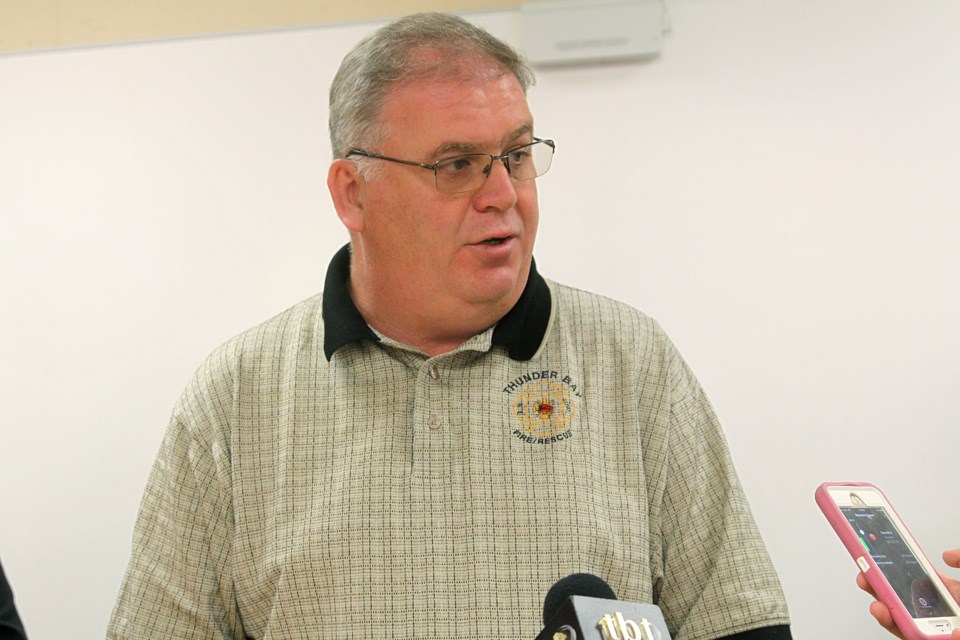THUNDER BAY – The city is halting acceptance of additional evacuees forced out of their communities by wildfires, with resources already devoted to one of the largest evacuation support efforts in Thunder Bay’s history.
Nearly 1,000 Pikangikum First Nation residents, who have been forced to flee after a full evacuation was ordered with a massive 50,000-hectare blaze burning within six kilometres of the community, are in Thunder Bay. The provincially coordinated effort brought 236 people to the city on Wednesday, joining about 700 others who had arrived in Thunder Bay after self-evacuating.
“We are beyond our ability to provide care and comfort for those people but we are doing our best,” Thunder Bay city manager Norm Gale said at a Thursday afternoon news conference.
“Our focus will be on the 1,000 people – plus or minus – that we have here in the city today. Accordingly, we will accept no more evacuees.”
Thunder Bay police chief Sylvie Hauth said the influx of evacuees has already had an impact on emergency services.
“The last thing we want to do is not be able to respond to day-to-day calls for service, whether it be through our front desk or our emergency line through 911 and that goes for fire, police and EMS,” Hauth said.
“In a situation like this, we’ve already noticed in the last 24 hours some greater demands, both on EMS and police resources in terms of calls for service, calls for assistance. We want to ensure the almost 1,000-plus evacuees that are here are receiving the support they need and the help they need, at the time they require so.”
At a news conference one day earlier, city officials said they were preparing to host an additional 100 evacuees on Friday with the expectation of increased capacity to bring in 100 more people next week, while emphasizing that the lack of other willing host communities in Ontario had stretched Thunder Bay’s hosting capability beyond capacity.
Since then, Saskatchewan has committed to assist evacuation efforts by offering to bring in 2,000 people.
“The move by Saskatchewan was extraordinarily helpful,” Gale said. “It is a big deal. It does matter and Saskatchewan accepting 2,000 people has made a significant difference to us here in Thunder Bay.”
The self-evacuated contingent, which is being assisted by the Independent First Nations Alliance (IFNA), is being hosted in two local hotels. Although they had not been receiving direct support from the city’s evacuation response as of Wednesday, a command group will be established on Thursday.
“We want to liaise. We want to connect. We want to, first of all, support IFNA in their efforts and we want to help out in any we can and focus on the people that are here now,” Gale said.
“One thousand people are here now, and that’s the largest evacuation we’ve seen since 2006 and likely the largest evacuation ever for the city of Thunder Bay.”
Pikangikum, which has an on-reserve population of 4,300, has now had residents forced out their homes twice in less than two months because of forest fires. The most recent blaze – Red Lake 39 – started on June 30 and a full evacuation of the community began on Monday.
Mathew Hoppe, the Independent First Nations Alliance’s emergency operations centre commander, said extreme fire behaviour earlier in the week required drastic efforts to get as many people out as quickly as possible.
Those efforts included people, who were boated out from the community to where they had vehicles stored in Taxi Bay, to drive to Thunder Bay, though there were some coordinated bus and caravan expeditions.
There are still about 2,000 people in the community remaining as of Thursday, Hoppe said, adding that all ground evacuations have been suspended and those people are being encouraged to utilize the available flights to Saskatchewan.
Hoppe said support effort organizers will be exploring activities for community members, including potential summer school for youth.
“We’re looking at positives and ways we can turn this thing around real quick and keep people busy, provide supports to the kids. We’re looking forward to taking in the festivities and opportunities in the Thunder Bay area and at the same time too accepting volunteers to help us work together,” Hoppe said.
“I would like to say this is going to be a short one. I hope for a short one but at the same time, if it is extended I look forward to the support from Thunder Bay.”
The latest exodus from Pikangikum is the third time in recent months Thunder Bay has hosted evacuees from remote Northwestern Ontario First Nations communities. A previous fire prompted about 1,600 vulnerable community members from Pikangikum to be sent out in late May and early June, with about 400 arriving in Thunder Bay. Earlier, more than 200 evacuees from Kashechewan First Nation stayed in the city as rising Albany River water levels threatened the James Bay area community.
